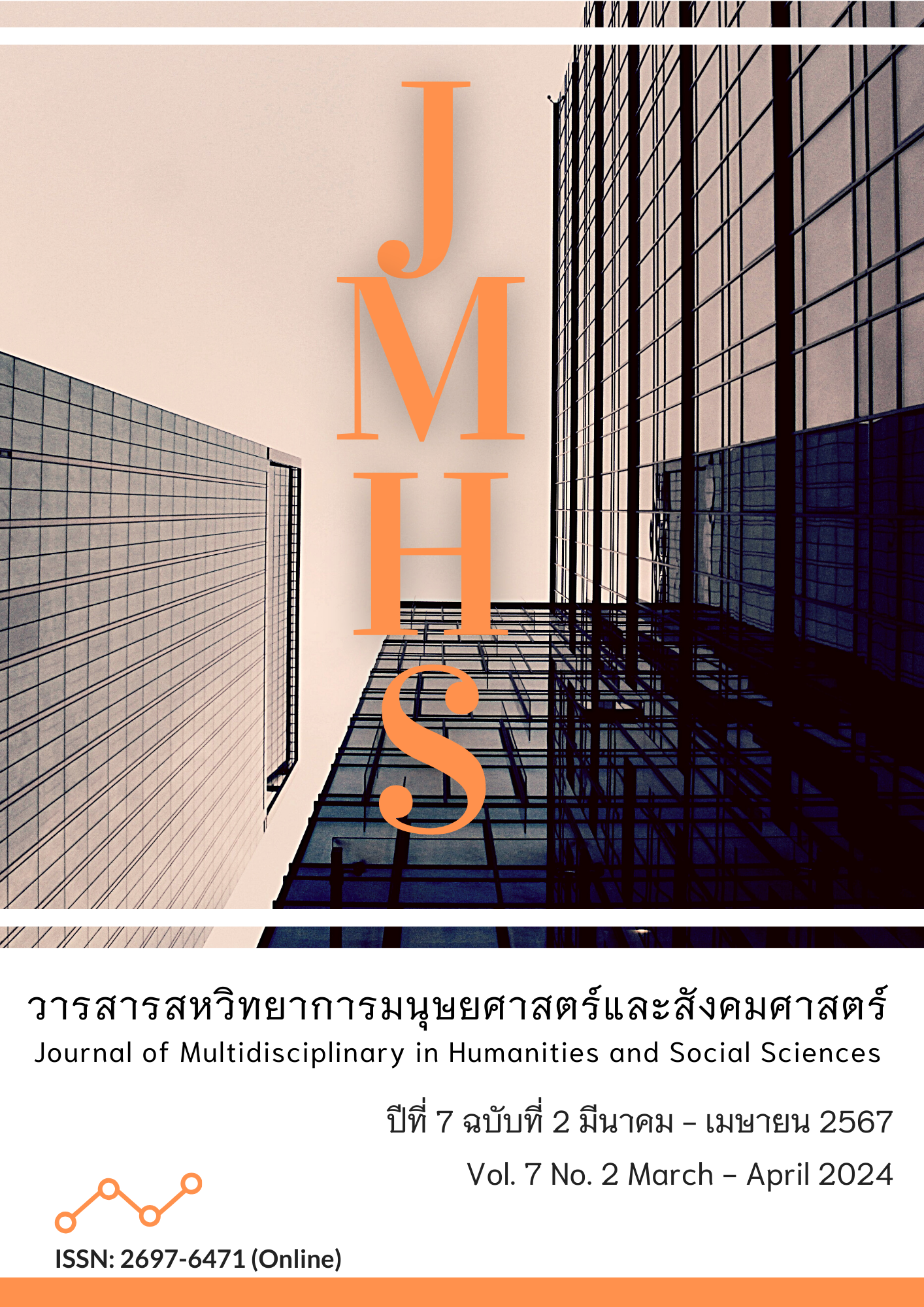ความสัมพันธ์เชิงสาเหตุของความพึงพอใจที่ส่งผลต่อความภักดีของผู้ใช้บริการสปาและนวดแผนไทย ในจังหวัดกาญจนบุรี
Main Article Content
บทคัดย่อ
บทความนี้มีวัตถุประสงค์ เพื่อศึกษาความสัมพันธ์เชิงสาเหตุของความพึงพอใจที่ส่งผลต่อความภักดีของผู้ใช้บริการสปาและนวดแผนไทย ในจังหวัดกาญจนบุรี รูปแบบการวิจัยเป็นการวิจัยเชิงปริมาณ ใช้แนวคิดและทฤษฎีแนวคิดทฤษฎีคุณภาพการบริการ แนวคิดทฤษฎีความพึงพอใจในบริการ แนวคิดทฤษฎีเกี่ยวกับคุณค่าตราสินค้า และแนวคิดทฤษฎีความภักดีของผู้รับบริการเป็นกรอบการวิจัย พื้นที่วิจัยคือ จังหวัดกาญจนบุรี กลุ่มตัวอย่าง คือ ผู้ใช้บริการสปาและนวดแผนไทย ในจังหวัดกาญจนบุรี จำนวน 240 คน ใช้วิธีคัดเลือกแบบเจาะจง เครื่องมือที่ใช้ในการวิจัย มี 1 ชนิด คือ แบบสอบถาม โดยตรวจสอบปัจจัยสาเหตุ ได้แก่ คุณภาพการบริการ คุณค่าตราสินค้าที่มีความสัมพันธ์กับปัจจัยผล ได้แก่ ความภักดีของผู้ใช้บริการ โดยผ่านตัวแปรกลาง ความพึงพอใจของผู้ใช้บริการ (กำหนดขนาดตัวอย่าง 10 เท่าของตัวแปรสังเกต ในที่นี้มี 16 ตัวแปรสังเกต วิเคราะห์ข้อมูลโดยใช้สถิติเชิงพรรณนา ได้แก่ ค่าความถี่ ร้อยละ ค่าเฉลี่ย และส่วนเบี่ยงเบนมาตรฐาน และสถิติเชิงอนุมาน คือ แบบจำลองสมการโครงสร้าง
ผลวิจัยพบว่า คุณภาพการบริการ มีอิทธิพลเชิงบวกต่อความพึงพอใจของผู้ใช้บริการ แต่ไม่มีอิทธิพลต่อความภักดีของผู้ใช้บริการ ในขณะที่คุณค่าตราสินค้า มีอิทธิพลเชิงบวกกับความพึงพอใจของผู้ใช้บริการ และความภักดีของผู้ใช้บริการ นอกจากนี้ความพึงพอใจของผู้ใช้บริการ มีอิทธิพลเชิงบวกต่อความภักดีของผู้ใช้บริการ งานวิจัยนี้ชี้ให้เห็นว่าการสร้างความภักดีของผู้ใช้บริการธุรกิจสปาและนวดแผนไทย ในจังหวัดกาญจนบุรี ที่เกิดจากความพึงพอใจนั้นควรมุ่งเน้นที่คุณค่าตราสินค้า และคุณภาพการบริการ ตามลำดับ
ข้อค้นพบจากงานวิจัยนี้ คือ สำหรับธุรกิจสปาและนวดแผนไทยในจังหวัดกาญจนบุรี นั้นพบว่า 1) การสร้างความภักดีสามารถสร้างได้จากคุณค่าตราสินค้า และคุณภาพการบริการ 2) คุณภาพการบริการ ไม่สามารถทำให้ผู้มารับบริการเกิดความจงรักภักดีได้โดยตรง แต่จำเป็นต้องทำให้ลูกค้าเกิดความพึงพอใจเสียก่อน 3) คุณค่าตราสินค้า สามารถสร้างความภักดีให้เกิดขึ้นแก่ผู้มารับบริการได้โดยตรงและผ่านความพึงพอใจ
Article Details

This work is licensed under a Creative Commons Attribution-NonCommercial-NoDerivatives 4.0 International License.
ทัศนะและความคิดเห็นที่ปรากฏในวารสาร ถือเป็นความรับผิดชอบของผู้เขียนบทความนั้น และไม่ถือเป็นทัศนะและความรับผิดชอบของกองบรรณาธิการ
References
กรมสนับสนุนบริการสุขภาพ, กระทรวงสาธารณสุข. (2564). คำขออนุญาตสถานประกอบการเพื่อสุขภาพ ประเภทสปานวดเพื่อสุขภาพ นวดเพื่อเสริมความงาม. สืบค้นจาก https://hss.gdcatalog.go.th/dataset/0bd0a549-7d47-4d5e-ada9-0ef4e25beb3f/resource/0ffd5f8e-ce14-4c14-9fbe-648eb7510666/download/hss__.xlsx
กระทรวงการท่องเที่ยวและกีฬา. (2565). มิติใหม่!! สาธารณสุข - ท่องเที่ยว MOU ขับเคลื่อนเศรษฐกิจ. สืบค้นจาก https://www.mots.go.th/news-view.php?nid=13103
กิตติภัทท์ ปรีดาธรรม, ศักดิ์ชัย เศรษฐ์อนวัช, วุฒิชาติ สุนทรสมัย และ อติชาติ โรจนกร. (2566). การพัฒนาความจงรักภักดีของผู้รับบริการธุรกิจสปาและนวดเพื่อ
สุขภาพ ในอุตสาหกรรมบริการไทย. วารสารการจัดการธุรกิจ มหาวิทยาลัยบูรพา, 12(2), 48–67. สืบค้นจาก https://so01.tci-thaijo.org/index.php/BJBM/article/view/267828
กฤษณา ทัพวงษ์ และ ถนอมพงษ์ พานิช. (2559). ปัจจัยทางการตลาดสำหรับธุรกิจคาร์แคร์ที่มีผลต่อความจงรักภักดีของผู้บริโภค: กรณีศึกษา อำเภอเมือง จังหวัดชลบุรี. วารสารวิทยาลัยบัณฑิตศึกษาการจัดการ มหาวิทยาลัยขอนแก่น, 9(2), 294-317. สืบค้นจาก https://so04.tci-thaijo.org/index.php/mbakkujournal/article/view/77644
ฉัตยาพร เสมอใจ. (2549). การจัดการและการตลาดบริการ. กรุงเทพฯ: ซีเอ็ดยูเคชั่น.
ฉัตรชัย ตั้งทรัพย์ และ สืบชาติ อันทะไชย. (2563). ปัจจัยที่มีอิทธิพลต่อความพึงพอใจและความจงรักภักดีของลูกค้าในการใช้บริการร้านค้าปลีกแบบดั้งเดิมในเขตเทศบาลเมืองหนองคาย. RMUTT Global Business and Economics Review, 15(2), 19-32. สืบค้นจาก https://so03.tci-thaijo.org/index.php/RMUTT-Gber/article/view/241507
ชนิภรณ์ แก้วเนิน, มณัฐนรี สมิตร และ อรรถเวทย์ พฤกษ์สถาพร. (2563). พฤติกรรม การรับรู้ และทัศนคติของผู้บริโภคต่อสินค้าและการใช้บริการตามกระแสเกาหลีนิยม. วารสารวิทยาลัยดุสิตธานี, 14(3), 277–294. สืบค้นจาก https://so01.tci-thaijo.org/index.php/journaldtc/article/view/245515
ศูนย์วิจัยกสิกรไทย. (2565). เปิดประเทศเต็มรูปแบบ ก้าวสำคัญของตลาดต่างชาติเที่ยวไทย (กระแสร์ทรรศน์ ฉบับที่ 3323). สืบค้นจาก https://www.kasikornresearch.com/th/analysis/k-econ/business/Pages/Reopening-z3323.aspx
สุพริศร์ สุวรรณิก. (2565). สปาและนวดแผนไทย…จะไปอย่างไรต่อ?. สืบค้นจาก https://www.bot.or.th/Thai/ResearchAndPublications/DocLib_/Article_15May2021.p
Ariff, S. M., Yun, O. L., Zakuan, N., & Ismail, K. (2013). The Impacts of Service Quality and Customer Satisfaction on Customer Loyalty in Internet Banking. Procedia-Social and Behavioral Sciences, 81, 469-473. https://doi.org/10.1016/j.sbspro.2013.06.462
Baumann, C., Hoadley, S., Hamin H., & Nugraha, A. (2017). Competitiveness Vis-À-Vis Service Quality as Drivers of Customer Loyalty Mediated by Perceptions of Regulation and Stability in Steady and Volatile Markets. Journal of Retailing and Consumer Services, 36, 62-74. https://doi.org/10.1016/j.jretconser.2016.12.005
Cantrell, M. A., & Lupinacci, P. (2007). Methodological Issues in Online Data Collection. Journal of Advanced Nursing, 60(5), 544-549. https://doi.org/10.1111/j.1365-2648.2007.04448.x
Chae, H., & Ko, E. (2016). Customer Social Participation in the Social Networking Services and its Impact Upon the Customer Equity of Global Fashion Brands. Journal of Business Research, 69(9), 3804-3812. https://doi.org/10.1016/j.jbusres.2015.12.072
Chao, S., Yu, M., & Sun, Y. (2023). Ascertaining The Effects of Service Quality on Customer Loyalty in The Context of Ocean Freight Forwarders: An Integration of Structural Equation Modeling and Network Data Envelopment Analysis. Transportation Business & Management, 47, 100955. https://doi.org/10.1016/j.rtbm.2023.100955
Chow, H. W., Ling, G. J., Yen, I. Y., & Hwang, K. P. (2017). Building Brand Equity Through Industrial Tourism. Asia Pacific Management Review, 22(2), 70-79. https://doi.org/10.1016/j.apmrv. 2016.09.001
Gazi, I. Md., Mamun, A. A., Masud, A. A., Senathirajah, A. S., & Rahman, T. (2024). The Relationship Between CRM, Knowledge Management, Organization Commitment, Customer Profitability and Customer Loyalty in Telecommunication Industry: The Mediating Role of Customer Satisfaction and The Moderating Role of Brand Image. Journal of Open Innovation: Technology, Market, and Complexity, 10(1), 100227. https://doi.org/10.1016/j.joitmc.2024.100227
Giovanis, N.A., Zondiros, D., & Tomaras, P. (2014). The Antecedents of Customer Loyalty for Broadband Services: The Role of Service Quality, Emotional Satisfaction and Corporate Image. Procedia Social and Behavioral Sciences, 148, 236-244. https://doi.org/10.1016/j.sbspro.2014.07.039
Hair, J. F., Black, W. C., Babin, B. J., & Anderson, R. F. (2010). Multivariate Data Analysis: A Global Perspective. (7th ed.). New Jersey: Prentice-Hall.
Harris, L. C., & Goode, M. H. (2004). The Four Levels of Loyalty and The Pivotal Role of Trust: A Study of Online Service Dynamics. Journal of Retailing, 80(2), 139–158. https://doi.org/10.1016/j.jretai.2004.04.002
Hosseini, S. R., Zainal, A., & Sumarjan, S. (2015). The Effects of Service Performance of Hotel Customers on Quality of Experience and Brand Loyalty in Iran. Procedia Social and Behavioral Sciences, 201, 156–164. https://doi.org/10.1016/j.sbspro.2015.08.163
Islam, T., Islam, R., Pitafi, A. H., Xiaobei, L., Rehmani, M., Irfan, M., & Mubarak, M. S. (2021). The Impact of Corporate Social Responsibility on Customer Loyalty: The Mediating Role of Corporate Reputation, Customer Satisfaction, and Trust. Sustainable Production and Consumption, 25, 123-135. https://doi.org/10.1016/j.spc.2020.07.019
Jamaluddin, R. M., Hanafoah, H. M., & Zulkifly, I. M. (2013). Customer-Based Psychology Branding. Procedia-Social and Behavioral Sciences, 105, 772-780. https://doi.org/10.1016/j.sbspro.2013.11.080
Kim, W., Kim, H., & Hwang, J. (2020). Sustainable Growth for The Self-Employed in The Retail Industry Based on Customer Equity, Customer Satisfaction, and Loyalty. Journal of Retailing and Consumer Services, 53. 101963 https://doi.org/10.1016/j.jretconser.2019. 101963
Markovic, S., & Raspor, S. (2010). Measuring Perceived Service Quality Using SERVQUAL: A Case Study of The Croatian Hotel Industry. Management, 5(3), 195-209.
Matsuoka, K. (2022). Effects Of Revenue Management on Perceived Value, Customer Satisfaction, and Customer Loyalty. Journal of Business Research, 148, 131-148. https://doi.org/10.1016/j.jbusres.2022.04.052
Mody, M., Hanks, L., & Dogru, T. (2019). Parallel Pathways to Brand Loyalty: Mapping the Consequences of Authentic Consumption Experiences for Hotels and Airbnb. Journal of Tourism Management, 74, 65-80. https://doi.org/10.1016/j.tourman.2019.02.013
Oliver, R. L. (1999). Whence Consumer Loyalty? Journal of Marketing, 63(4), 33-44. https://doi.org/10.2307/1252099
Rasheed, A. F., & Abadi, F. A. (2014). Impact of Service Quality, Trust and Perceived Value on Customer Loyalty in Malaysia Services Industries. Procedia-Social and Behavioral Sciences, 164, 298-304. https://doi.org/10.1016/j.sbspro.2014.11.080
Segoro, W. (2013). The Influence of Perceived Service Quality, Mooring Factor, and Relationship Quality on Customer Satisfaction and Loyalty. Procedia-Social and Behavioral Sciences, 81, 306-310. https://doi.org/10.1016/j.sbspro.2013.06.433
Tan, L.P., Rasoolimanesh, M.S., & Manickam, G. (2022). How Corporate Social Responsibility Affects Brand Equity and Loyalty? A Comparison Between Private and Public Universities. Heliyon, 8(4), 1-12. https://doi.org/10.1016/j.heliyon.2022.e09266
Zakaria, I., Rahman, B., Othman, K.A., Yunus, N. M., Dzulkipli, R. M., & Oaman, M. F. (2013). The Relationship between Loyalty Program, Customer Satisfaction and Customer Loyalty in Retail Industry: A Case Study. Procedia-Social and Behavioral Sciences, 129, 23-30. https://doi.org/10.1016/j.sbspro.2014.03.643

